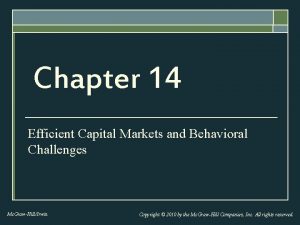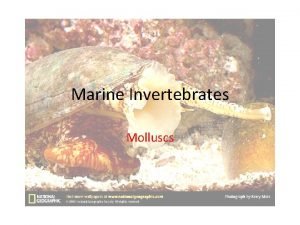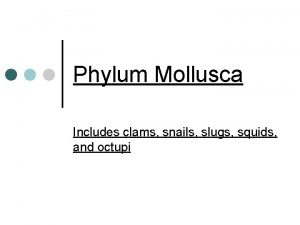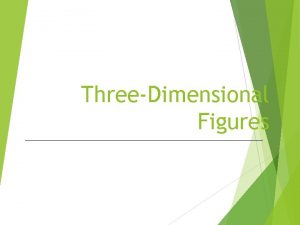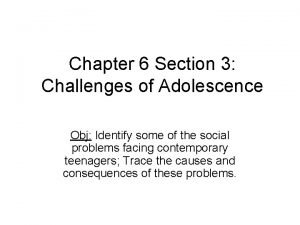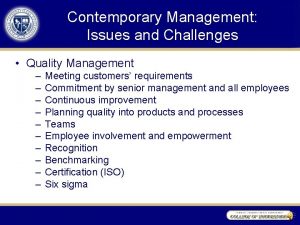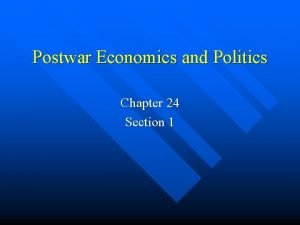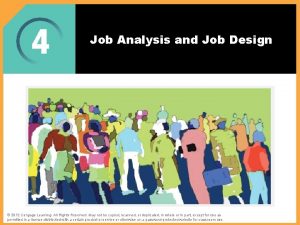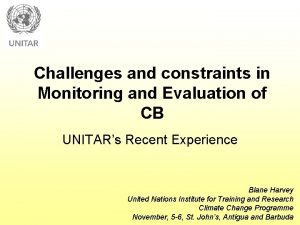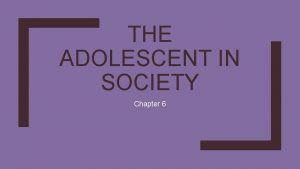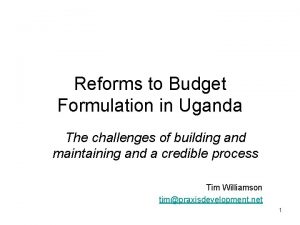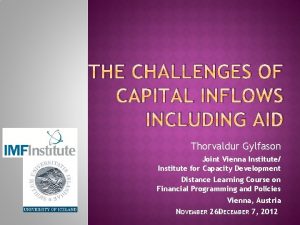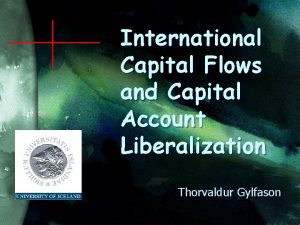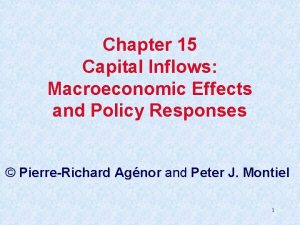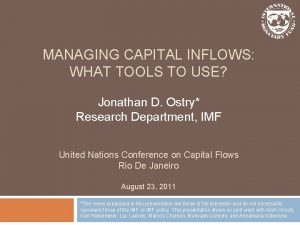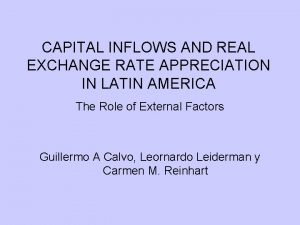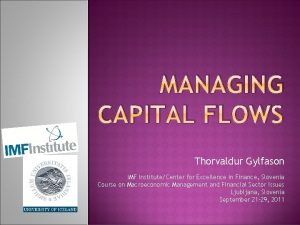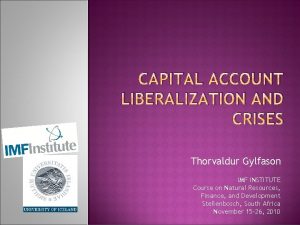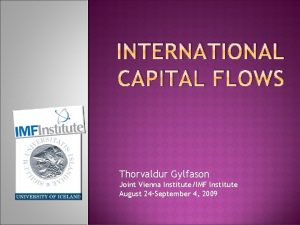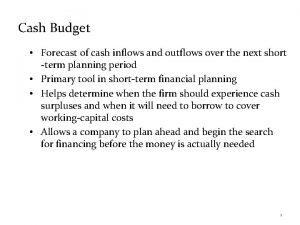THE CHALLENGES OF CAPITAL INFLOWS INCLUDING AID Thorvaldur






























































































- Slides: 94

THE CHALLENGES OF CAPITAL INFLOWS INCLUDING AID Thorvaldur Gylfason Stellenbosch, South Africa 2 -13 November 2009

OUTLINE �Capital flows �History, theory, evidence �Foreign aid �Effectiveness: Does aid work? �Macroeconomic challenges Dutch disease Aid volatility �Policy options in managing aid flows Preparing for scaling up aid Monetary and fiscal policy options Debt sustainability Governance issues �Conclusions and guidelines

1 CAPITAL FLOWS � Definition International capital movements refer to the flow of financial claims between lenders and borrowers o The lenders give money to the borrowers to be used now in exchange for IOUs or ownership shares entitling them to interest and dividends later o � Benefits of international trade in capital Allows for specialization, specialization like trade in commodities o Allows for intertemporal trade in goods and services between countries o Allows for international diversification of risk o 3

GOODS AND CAPITAL The case for free trade in goods and services applies also to capital Trade in capital helps countries to specialize according to comparative advantage, advantage exploit economies of scale, scale and promote competition Exporting equity in domestic firms not only earns foreign exchange, but also secures access to capital, ideas, knowhow, technology But financial capital is volatile

SYMMETRY BETWEEN GOODS AND CAPITAL The balance of payments R = X – Z + F where d i a s e d u l c n i X R = change in foreign reserves X = exports of goods and services Z = imports of goods and services F = FX – FZ = net exports of capital Foreign direct investment (net) Portfolio investment (net) Foreign borrowing, net of amortization

DETERMINANTS OF TRADE IN GOODS AND SERVICES Trade in goods and services depends on Relative prices at home and abroad Exchange rates (elasticity models) National incomes at home and abroad Geographical distance from trading partners (gravity models) Trade policy regime Tariffs and other barriers to trade

DETERMINANTS OF TRADE IN CAPITAL Again, capital flows consist of foreign borrowing, portfolio investment, and foreign direct investment (FDI) Trade in capital depends on Interest rates at home and abroad Exchange rate expectations Geographical distance from trading partners Capital account policy regime Capital controls and other barriers to free flows

CAPITAL FLOWS: FOR WHAT? Facilitate borrowing abroad to smooth consumption over time Dampen business cycles Reduce vulnerability to domestic economic disturbances Increase risk-adjusted rates of return Encourage saving, investment, and economic growth

CAPITAL FLOWS: CONCEPTUAL FRAMEWORK Emerging countries save a little Real interest rate Saving Investment Loanable funds

CAPITAL FLOWS: CONCEPTUAL FRAMEWORK Real interest rate Industrial countries save a lot Saving Investment Loanable funds

CAPITAL FLOWS: CONCEPTUAL FRAMEWORK Emerging countries Industrial countries Financial globalization encourages investment in emerging countries and saving in industrial countries Real interest rate Saving Borrowing Investment Loanable funds Lending Saving Investment Loanable funds

RELEVANCE AND CONTEXT �Since 1945, trade in goods and services has been gradually liberalized (GATT, WTO) Big exception: Agricultural commodities �Since 1980 s, trade in capital has also been freed up Capital inflows (i. e. , foreign funds obtained by the domestic private and public sectors) have become a large source of financing for many emerging market economies

EVOLUTION OF CAPITAL FLOWS Capital mobility A stylized view of capital mobility 1860 -2000 First era of international financial integration Return toward financial integration Capital controls Source: Obstfeld & Taylor (2002), “Globalization and Capital Markets, ” NBER WP 8846.

15 Source: IMF WEO, Oct. 2007, Chapter 3, Figure 3. 1. NET PRIVATE CAPITAL FLOWS TO EMERGING MARKETS, 1980 -2007

CONCENTRATION OF NET PRIVATE CAPITAL FLOWS TO SELECTED COUNTRIES, 1990 -2007 Source: IMF, World Economic Outlook database.

TOTAL CAPITAL INFLOWS (USD, BILLIONS)

NET PRIVATE CAPITAL INFLOWS: ALL EMERGING MARKETS, 1990 -2007 Source: IMF, World Economic Outlook database.

Africa: Net Capital Flows 1980 -2008 Source: IMF WEO

CAUSES OF CAPITAL INFLOWS: PUSH VS. PULL FACTORS Capital flows result from interaction between supply and demand Capital is “pushed” pushed away from investor countries Investors supply capital to recipients Capital is “pulled” pulled into recipient countries Recipients demand capital from investors

CAUSES OF CAPITAL INFLOWS: PUSH VS. PULL FACTORS Internal factors “pulled” pulled capital into LDCs from industrial countries Macroeconomic fundamentals in LDCs More productivity, more growth, less inflation Structural reforms in LDCs Liberalization of trade Liberalization of financial markets Lower barriers to capital flows Higher ratings from international agencies

CAUSES OF CAPITAL INFLOWS: PUSH VS. PULL FACTORS External factors “pushed” pushed capital from industrial countries to LDCs Cyclical conditions in industrial countries Recessions in early 1990 s reduced investment opportunities at home Declining world interest rates made IC investors seek higher yields in LDCs Structural changes in industrial countries Financial structure developments, lower costs of communication Demographic changes: Aging populations save more

PUSH FACTORS Institutional investors, banks, and firms in mature markets increasingly invest in emerging markets assets to diversify and enhance risk-adjusted returns (i. e. , to reduce “home bias”), owing to Low interest rates at home, high liquidity in mature markets, stimulus from “yen” carry trade § Demographic changes, rise in pension funds in mature markets § Changes in accounting and regulatory environment allowing more diversification of assets §

PULL FACTORS Structural changes in emerging markets Better financial market infrastructure § Improved corporate and financial sector governance § More liberal regulations regarding foreign portfolio inflows § Stronger macroeconomic fundamentals Solid current account positions (except in emerging European countries) § Improved debt management § Large accumulation of reserve assets §

EFFECTS OF CAPITAL INFLOWS: POTENTIAL BENEFITS Improved allocation of global savings allows capital to seek highest returns Greater efficiency of investment More rapid economic growth Reduced macroeconomic volatility through risk diversification dampens business cycles Income smoothing Consumption smoothing

EFFECTS OF CAPITAL INFLOWS: POTENTIAL RISKS Open capital accounts may make receiving countries vulnerable to foreign shocks Magnify domestic shocks and lead to contagion Limit effectiveness of domestic macroeconomic policy instruments Countries with open capital accounts are vulnerable to Shifts in market sentiment Reversals of capital inflows May lead to macroeconomic crisis Sudden reserve loss, exchange rate pressure Excessive BOP and macroeconomic adjustment Financial crisis

EFFECTS OF CAPITAL INFLOWS: POTENTIAL RISKS Overheating of the economy Excessive expansion of aggregate demand with inflation, real currency appreciation, widening current account deficit Increase in consumption and investment relative to GDP § Quality of investment suffers § Construction booms – count the cranes! Monetary consequences of capital inflows and accumulation of foreign exchange reserves depend on exchange regime § Fixed exchange rate: Inflation takes off § Flexible rate: Appreciation fuels spending boom

EPISODES OF LARGE NET PRIVATE CAPITAL INFLOWS: NUMBER, SIZE, AND ENDING Source: IMF WEO, Oct. 2007, Chapter 3, Table 3. 1.

REAL STOCK PRICES DURING INFLOW PERIODS, SELECTED COUNTRIES Chile 1978 -81 Mexico Venezuela Chile 1989 -94 Sweden Finland Year with respect to start of inflow period Note: The index for Finland, Mexico, and Sweden is shown on the left; the index for Chile during the 1980 s and 1990 s and for Venezuela is shown on the right. Source: World Bank (1997).

EARLY WARNING SIGNS Large deficits Current account deficits Government budget deficits Poor bank regulation Government guarantees (implicit or explicit), moral hazard Stock and composition of foreign debt Ratio of short-term liabilities to foreign reserves Mismatches Maturity mismatches (borrowing short, lending long) Currency mismatches (borrowing in foreign currency, lending in domestic currency)

RATIO OF SHORT-TERM LIABILITIES TO FOREIGN RESERVES IN ASIA 1997 an p s n e e r G it t o id u G rule

LARGE REVERSALS

RECENT EXPERIENCES WITH CAPITAL ACCOUNT LIBERALIZATION External or financial crisis followed capital account liberalization E. g. , Mexico, Sweden, Turkey, Korea, Paraguay, Iceland Response Rekindled support for capital controls Focus on sequencing of reforms Sequencing makes a difference Strengthen financial sector and prudential framework before removing capital account restrictions Remove restrictions on FDI inflows early Liberalize outflows after macroeconomic imbalances have been addressed

SOME TYPES OF CAPITAL FLOWS ARE RISKIER THAN OTHERS High degree of risk sharing Portfolio equity Foreign direct investment Short term debt Long term debt (bonds) No risk sharing Transitory Permanent

SEQUENCING CAPITAL ACCOUNT LIBERALIZATION Pre-conditions for liberalization Sound macroeconomic policies Strong domestic financial system Strong and autonomous central bank Timely, accurate, and comprehensive data disclosure

FINANCIAL CRISES IN 1990 S CALLED CAPITAL LIBERALIZATION IN DOUBT �Financial globalization is often blamed for crises in emerging markets �It was suggested that emerging markets had dismantled capital controls too hastily, leaving themselves vulnerable �More radically, some economists view unfettered capital flows as disruptive to global financial stability �These economists call for capital controls and other curbs on capital flows (e. g. , taxes) �Others argue that increased openness to capital flows has proved essential for countries seeking to rise from lower-income to middleincome status

ROLE OF CAPITAL CONTROLS �Capital controls aim to reduce risks associated with excessive inflows or outflows � Specific objectives may include �Protecting a fragile banking system �Avoiding quick reversals of short-term capital inflows following an adverse macroeconomic shock �Reducing currency appreciation when faced with large inflows �Stemming currency depreciation when faced with large outflows �Inducing a shift from shorter- to longerterm inflows

TYPES OF CAPITAL CONTROLS � Administrative �Outright controls bans, quantitative limits, approval procedures � Market-based �Dual or �Explicit controls multiple exchange rate systems taxation of external financial transactions �Indirect taxation E. g. , unremunerated reserve requirement � Distinction �Controls inflows between on inflows and controls on outflows on different categories of capital

IMF ANNUAL REPORT ON EXCHANGE ARRANGEMENTS AND EXCHANGE RESTRICTIONS �IMF (which has jurisdiction over current account, not capital account, restrictions) maintains detailed compilation of member countries’ capital account restrictions �The information in the AREAER has been used to construct measures of financial openness based on a 1 (controlled) to 0 (liberalized) classification �They show a trend toward greater financial openness during the 1990 s �But these measures provide only rough indications because they do not measure the intensity or effectiveness of capital controls (de jure versus de facto measures)



CONCLUSION ON CAPITAL FLOWS �Capital flows can play an important role in economic growth and development �But they can also create macroeconomic vulnerabilities �Recipient countries need to manage capital flows so as to avoid hazards �Need sound policies as well as effective institutions, including financial supervision, and good timing

2 FROM CAPITAL INFLOWS TO AID: DEFINITION �Development aid �Unrequited transfers from donor to country designed to promote the economic and social development of the recipient (excluding commercial deals and military aid) �Concessional loans and grants included, by tradition �Grant element ≥ 25%

DEFINITION �Development aid can be �Public or private �Bilateral (from one country to another) or multilateral (from international organizations) �Program, project, technical assistance �Linked to purchase of goods and services from donor country, or in kind �Conditional in nature IMF conditionality, good governance

MOTIVATION: WHY AID? �Moral duty �Neocolonialism �Humanitarian intervention �Public good �National (e. g. , education and health care) �International Social justice to promote world unity UN aid commitment of 0. 7% of GDP �World-wide redistribution �Increased inequality word-wide �Marshall Plan after World War II 1. 5% of US GDP for four years vs. 0. 2% today Think tank in Nairobi disagrees, see www. irenkenya. com

MOTIVATION: WHY AID? �Objectives �Individuals in donor countries vs. governments in recipient countries Who should receive the aid? �Today’s poor vs. tomorrow’s poor Aid for consumption vs. investment �Conflicts �Beneficiaries’ needs �Donors’ interests

PAST TRENDS �Aid is a recent phenomenon �Four major periods since 1950 � 1950 s: Fast growth (US, France, UK) � 1960 s: Stabilization and new donors Japan, Germany, Canada, Australia � 1970 s: Rapid growth in aid again due to oil shocks, recession, cold war � 1980 s: Stagnation, aid fatigue, new methods

PAST TRENDS: 1950 S �Rapid growth of development aid �US provided 50% of total ODA �To countries ranging from Greece to South Korea along the frontier of the “Sino. Soviet bloc” �France �To �UK provided 30% former colonies, mainly in West Africa provided 10% �To Commonwealth countries

PAST TRENDS: 1960 S �Stabilization of aid from traditional donors and emergence of new donors �US contribution decreased considerably after the Kennedy presidency (1961 -63) �The French contribution decreased starting from the early 1960 s �New donors included Japan, Germany, Canada, and Australia

PAST TRENDS: 1970 S �Rapid growth in aid from industrial countries in response to the needs of developing countries due to �Oil shocks �Severe drought in the Sahel �The donor governments promised to deliver 0. 7% of GNI in ODA at the UN General Assembly in 1970 �The deadline for reaching that target was the mid-1970 s

PAST TRENDS: 1980 S AND 1990 S �Stagnation of development assistance �Donor fatigue? �Private investor fatigue?

DONOR FATIGUE? 56

WHO ARE THE DONORS? �United States: largest donor in volume, but low in relation to GDP �US aid amounts to 0. 2% of GDP �Japan: second-largest donor in volume �Nordic countries, Netherlands �Major donors to multilateral programs �Only countries whose assistance accounts for 0. 7% of GDP �EU: leading multilateral donor

WHO ARE THE DONORS? �Even though targets and agendas have been set, year after year, almost all rich nations have constantly failed to reach their agreed obligations of the 0. 7% target �Instead of 0. 7% of GNI, the amount of aid has been around 0. 4% (on average), some $100 billion short

OFFICIAL DEVELOPMENT ASSISTANCE BY DONOR 2005 (USD BILLION)

OFFICIAL DEVELOPMENT ASSISTANCE BY DONOR 2004 (% OF GNP)

GEOGRAPHICAL DISTRIBUTION OF AID (%)

A RECOVERY IN SIGHT? �The Blair Report and the Sachs Report called on world community to increase development aid (particularly for Africa) to enable developing countries to attain the MDGs by 2015 � 2005 G-8 Gleneagles communiqué called for raising annual aid flows to Africa by $25 billion per year by 2010 � 2005 UN Millennium Project called for $33 billion per year in additional resources For comparison, US gave $20 billion in 2004, not $70 billion as suggested by UN goal

MACROECONOMICS OF AID �Aid fills gap between investment needs and saving and increases growth �Poor countries often have low savings and low export receipts and limited investment capacity and slow growth �Aid is intended to free developing nations from poverty traps �Example: Capital stock declines if saving does not keep up with depreciation

MACROECONOMICS OF AID �The recent increase in aid flows toward developing countries (particularly Africa) poses crucial questions for both recipient countries and donors �What is the role of aid? �What is the macroeconomic impact of aid? �Is the impact of aid necessarily positive, or could aid have adverse consequences?

AID AND INVESTMENT To understand the link between aid and investment, consider resource constraint identity by rearranging the National Income Identity: Y=C+I+G+X–Z I = (Y – T – C) + (T – G) + (Z – X) In words, investment is financed by the sum of private saving, saving public saving, saving and foreign saving

AID AND INVESTMENT Rearrange again: Y+Z=E+X where E is expenditure E=C+I+G Total supply from domestic and foreign sources Y + Z equals total demand E + X Aid increases recipient’s ability to import: Z rises with increased X

AID AND GROWTH �Poor countries are trapped by poverty �Driving forces of growth (saving, technological innovation, accumulation of human capital) are weakened by poverty �Countries become stuck in poverty traps �Aid enables poor countries to free themselves of poverty by enabling them to cross the necessary thresholds to launch growth �Saving �Technology �Human capital

AID AND POVERTY Is it feasible to lift all above a dollar a day? How much would it cost to eradicate extreme poverty? Let’s do the arithmetic (Sachs) Number of people with less than a dollar a day is 1. 1 billion Their average income is 77 cents a day, they need 1. 08 dollars Difference amounts to 31 cents a day, or 113 dollars per year Total cost is 124 billion dollars per year, or 0. 6% of GNP in industrial countries Less than they promised! – and didn’t deliver

EMPIRICAL STUDIES OF AID �Several empirical studies have assessed the impact of aid on growth, saving, and investment �The results are somewhat inconclusive �Most studies have shown that aid has no significant statistical impact on growth, saving, or investment �However, aid has positive impact on growth when countries pursue “sound policies” �Burnside and Dollar (2000)

EMPIRICAL STUDIES OF AID �Regression analysis to measure the impact of aid on �Saving �Investment �Public finance �Economic growth

DOES AID WORK? DOMESTIC RESPONSES � Saving �Negative effect on saving Substitution effect? Boone, 1996; Reichel, 1995 �Positive effect for good performers E. g. , South-East Asia, Botswana � Investment �No impact on private investment �Positive impact for good performers � Public finance �Uncertain effect on public investment �Positive effect on public consumption

DOES AID WORK? DOMESTIC RESPONSES �Growth: Mixed results �Most early studies showed no statistically significant impact �Some more recent studies show negative impact �Bias and endogeneity issues �Need to distinguish between different types of aid �Leakages, cash vs. aid in kind

AID AND GROWTH Foreign aid has sometimes been compared to natural resource discoveries Aid and growth are inversely related across countries Cause and effect 156 countries, 1960 -2000 r = rank correlation r = -0. 36

DOES AID WORK? THE CURRENT DEBATE �No robust relationship between aid and growth �Aid works in “countries with good policies” �Aid works if measured correctly �Distinction between fast impact aid (infrastructure projects) and slow impact aid (education) �Infrastructure: High financial returns �Education and health: High social returns

IMPACT OF AID ON GROWTH AND INVESTMENT �So, empirical evidence is mixed �Need to distinguish between different types of aid �Need to acknowledge diminishing returns to aid as well as limits to domestic absorptive capacity �Need to clarify interaction with governance and good policies �Special case: Post-conflict situations

REASONS FOR THE POSSIBLE INEFFECTIVENESS OF AID I �Aid may lead to corruption �Aid may be misused, by donors as well as recipients �Donors: Excessive administrative costs �Recipients: Mismanagement, expropriation �Aid is badly distributed, sometimes for strategic reasons �Supporting opposition government against political

REASONS FOR THE POSSIBLE INEFFECTIVENESS OF AID II �Aid increases public consumption, not public investment �Aid is procyclical �When �Aid it rains, it pours leads to “Dutch disease” �Labor-intensive and export industries contract relative to other industries in countries receiving high aid inflows �Dutch disease may undermine external sustainability

REASONS FOR THE POSSIBLE INEFFECTIVENESS OF AID III �Aid volatility and unpredictability may undermine economic stability in recipient countries �Economic vs. social impact �Growth is perhaps not the best yardstick for the usefulness of aid �Long run vs. short run E. g. , increased saving reduces level of GDP in short run, but increases growth of GDP in long run

Online s ic m o n co E f o ry a n o Palgrave Dicti w e N e th in ” se a e is D See “Dutch DUTCH DISEASE �Appreciation of currency in real terms, either through inflation or nominal appreciation, leads to a loss of export competitiveness �In 1960 s, Netherlands discovered natural resources (gas deposits) �Currency appreciated �Exports of manufactures and services suffered, but not for long �Not unlike natural resource discoveries, aid inflows could trigger the Dutch Disease in receiving countries

IMPACT OF AID ON THE REAL EXCHANGE RATE �Review theory of Dutch disease in simple demand supply model

Real exchange rate BALANCE OF PAYMENTS EQUILIBRIUM Payments for imports of goods, services, and capital Imports Equilibrium Earnings from exports of goods, services, and capital Exports Foreign exchange

REAL EXCHANGE RATE Devaluation or depreciation of e makes Q also depreciate unless P rises so as to leave Q unchanged Q = real exchange rate e = nominal exchange rate P = price level at home P* = price level abroad

AID REDUCES EXPORTS Real exchange rate Aid leads to appreciation, and thus reduces exports C B A Imports Exports plus aid Exports Foreign exchange

OIL: SAME STORY Real exchange rate Oil discovery leads to appreciation, and reduces nonoil exports C B A Imports Exports plus oil Exports Foreign exchange

OIL: SAME STORY Real exchange rate Composition of exports matters C B A Imports Exports plus oil Exports Foreign exchange

THE RISK OF DUTCH DISEASE �A large inflow of foreign aid -- like a natural resource discovery -- can trigger a bout of Dutch disease in countries receiving aid �A real appreciation reduces the competitiveness of exports and might thus undermine economic growth �Exports have played a pivotal role in the economic development of many countries �An accumulation of “know-how” often takes place in the export sector, which may confer positive externalities on the rest of the economy

THE RISK OF DUTCH DISEASE �Aid spending can take several forms, with different macroeconomic implications: �Case 1: Aid received is saved by recipient country government �Case 2: Aid is used to purchase imported goods that would not have been purchased otherwise (grants in kind) �Case 3: Aid is used to buy nontradables with infinitely elastic supply �Case 4: Aid is used to buy nontradables for which there are supply constraints

DUTCH DISEASE: IS IT REAL? �Studies assessing empirical relevance of Dutch disease as caused by aid flows have produced mixed results �Aid was associated with real appreciation in Malawi and Sri Lanka �Aid was associated with real depreciation in Ghana, Nigeria, and Tanzania

LESSONS FROM SCALING UP AID �Ethiopia, Ghana, Tanzania, Mozambique, and Uganda experienced a surge in aid 1998 -2003 (Berg et al. 2007) �The net aid increment ranged from 2% of GDP in Tanzania to 8% of GDP in Ethiopia �High everywhere, from 7% to 20 % of GDP �In Ghana, sharp increase in 2001 followed by a slump in 2002 and another surge in 2003 �In all other countries, the surge in aid was persistent, i. e. , after the initial jump, aid inflows remained higher than before

AID-INDUCED DUTCH DISEASE: THE EVIDENCE �In the five countries, no evidence of aid-induced Dutch-Disease �Real exchange rates did not appreciate during the aid surges �Only Ghana had a small real appreciation while the others experienced a real depreciation From 1. 5% in Mozambique (2000) to 6. 5% in Uganda (2001) �Why? �The macroeconomic policy response was meant to avoid a real appreciation

WAS AID ABSORBED OR SPENT? POLICY RESPONSES �Countries were reluctant to absorb the surge in aid �Only Mozambique absorbed two-thirds �Aid surge led to reserve accumulation So, currency did not appreciate in real terms �Mozambique, Tanzania, and Uganda spent most of new aid �They had attained stability, so reducing domestic financing of the budget deficit was not a major goal �Ghana �They and Ethiopia spent little of the aid had a weak record of stability and low reserves, so reducing the domestic financing of the budget deficit was a consideration not to spend aid

WAS AID ABSORBED OR SPENT? POLICY RESPONSES Two types of policy response 1. In Ethiopia and Ghana, aid impact was limited because only a small part of it was either absorbed or spent �New aid was saved and reserves built up 2. In Mozambique, Tanzania, and Uganda, spending exceeded absorption, creating a pressure on prices �Money supply expansion was sterilized through treasury bill sales �Foreign exchange sales were kept consistent with a depreciation of currency to maintain competitiveness

MANAGEMENT OF AID FLOWS: MAIN LESSONS �Was aid-induced Dutch disease a problem? �No evidence of significant real appreciation following surge in aid �Macroeconomic policy response (fiscal and monetary policy mix) avoided real appreciation �“Not absorb and not spend” vs. “spend more than absorb”

FISCAL/AID OPTIONS: GRANTS VS. LOANS �Advantages of grants �Lower debt burden �Useful for social projects with uncertain or delayed returns (health care, education) �Advantage �Increase of concessional loans total flow of resources �Project allocation �Increase debt management capacity �Useful for projects yielding quick returns (infrastructure)

MANAGEMENT OF AID FLOWS: MAIN LESSONS � Aid can play a key role in the development of recipient countries, but it can also generate macroeconomic vulnerabilities � Recipients need to implement appropriate policies to manage aid flows to avoid macroeconomic hazards �The appropriate policy response needs to take into account Potential impact of aid on competitiveness Existence of constraints to aid absorption Risks linked to aid volatility and to external debt sustainability

AID VOLATILITY AND UNPREDICTABILITY � Aid is increasingly volatile and unpredictable �Aid flows are 6 -40 times more volatile than fiscal revenue �Volatility is largest for aid dependent countries (Bulir and Hamann 2003, 2007) �Volatility increased in the 1990 s �Aid delivery falls short of pledges by over 40% � Reasons for aid volatility �Donors: Changes in priorities; administrative and budgetary delays �Recipients: Failure to satisfy conditions � IMF conditionality often guides donors, helping them decide if the country’s policies are on track

CONSEQUENCES OF AID VOLATILITY Impact of large sudden inflows �Supply constraints in absorbing aid �Real exchange rate overshooting and volatility �Negative impact on export industries �Ratcheting up spending commitments without adequate consideration of exit strategy �Infrastructure investment without adequate planning for recurrent expenditure Impact of aid promised, but not disbursed �Spending commitments cannot be financed �Volatility in money supply, inflation, and exchange rates

SUMMARY AND GUIDELINES �From aid fatigue to new initiatives �Aid effectiveness is ambiguous �Positive results likely with better policies and governance �Five Primary Guidelines �Minimize risks of Dutch disease �Enhance growth �Promote good governance and reduce corruption �Prepare an exit strategy �Assess the policy mix

CONCLUSION ON AID THE END �Aid can play an important role in the growth and development of recipient countries … �… but it can also create macroeconomic vulnerabilities �Recipient countries need to manage aid flows so as to avoid hazards �Need to consider potential impact of aid on Competitiveness Constraints to aid absorption Risks linked to aid volatility and to external debt sustainability These slides will be posted on my website: www. hi. is/~gylfason
 First aid merit badge first aid kit
First aid merit badge first aid kit Neasden and greenhill medical centre
Neasden and greenhill medical centre Efficient capital markets and behavioral challenges
Efficient capital markets and behavioral challenges Difference between capital reserve and reserve capital
Difference between capital reserve and reserve capital Multinational cost of capital and capital structure
Multinational cost of capital and capital structure Introduction of working capital
Introduction of working capital Regulatory capital vs economic capital
Regulatory capital vs economic capital Capital allocation line vs capital market line
Capital allocation line vs capital market line Source of capital reserve
Source of capital reserve Regulatory capital vs economic capital
Regulatory capital vs economic capital Multinational capital structure
Multinational capital structure Constant vs variable capital
Constant vs variable capital Các châu lục và đại dương trên thế giới
Các châu lục và đại dương trên thế giới Từ ngữ thể hiện lòng nhân hậu
Từ ngữ thể hiện lòng nhân hậu Diễn thế sinh thái là
Diễn thế sinh thái là Tư thế ngồi viết
Tư thế ngồi viết Slidetodoc
Slidetodoc Thế nào là giọng cùng tên
Thế nào là giọng cùng tên Làm thế nào để 102-1=99
Làm thế nào để 102-1=99 Chúa yêu trần thế
Chúa yêu trần thế Khi nào hổ con có thể sống độc lập
Khi nào hổ con có thể sống độc lập đại từ thay thế
đại từ thay thế Quá trình desamine hóa có thể tạo ra
Quá trình desamine hóa có thể tạo ra Vẽ hình chiếu vuông góc của vật thể sau
Vẽ hình chiếu vuông góc của vật thể sau Công thức tính độ biến thiên đông lượng
Công thức tính độ biến thiên đông lượng Tỉ lệ cơ thể trẻ em
Tỉ lệ cơ thể trẻ em Thế nào là mạng điện lắp đặt kiểu nổi
Thế nào là mạng điện lắp đặt kiểu nổi Các loại đột biến cấu trúc nhiễm sắc thể
Các loại đột biến cấu trúc nhiễm sắc thể Lời thề hippocrates
Lời thề hippocrates Bổ thể
Bổ thể Vẽ hình chiếu đứng bằng cạnh của vật thể
Vẽ hình chiếu đứng bằng cạnh của vật thể độ dài liên kết
độ dài liên kết Các môn thể thao bắt đầu bằng tiếng nhảy
Các môn thể thao bắt đầu bằng tiếng nhảy Khi nào hổ con có thể sống độc lập
Khi nào hổ con có thể sống độc lập điện thế nghỉ
điện thế nghỉ Nguyên nhân của sự mỏi cơ sinh 8
Nguyên nhân của sự mỏi cơ sinh 8 Trời xanh đây là của chúng ta thể thơ
Trời xanh đây là của chúng ta thể thơ Gấu đi như thế nào
Gấu đi như thế nào Số nguyên tố là gì
Số nguyên tố là gì Thiếu nhi thế giới liên hoan
Thiếu nhi thế giới liên hoan Tia chieu sa te
Tia chieu sa te Các châu lục và đại dương trên thế giới
Các châu lục và đại dương trên thế giới Một số thể thơ truyền thống
Một số thể thơ truyền thống Thế nào là hệ số cao nhất
Thế nào là hệ số cao nhất Sơ đồ cơ thể người
Sơ đồ cơ thể người Tư thế ngồi viết
Tư thế ngồi viết đặc điểm cơ thể của người tối cổ
đặc điểm cơ thể của người tối cổ Hình ảnh bộ gõ cơ thể búng tay
Hình ảnh bộ gõ cơ thể búng tay Mật thư anh em như thể tay chân
Mật thư anh em như thể tay chân Chụp phim tư thế worms-breton
Chụp phim tư thế worms-breton ưu thế lai là gì
ưu thế lai là gì Thẻ vin
Thẻ vin Thể thơ truyền thống
Thể thơ truyền thống Cái miệng bé xinh thế chỉ nói điều hay thôi
Cái miệng bé xinh thế chỉ nói điều hay thôi Animal that only eats plants
Animal that only eats plants The committee debates or debate these questions carefully
The committee debates or debate these questions carefully Invertebrates including snails slugs and mussels
Invertebrates including snails slugs and mussels Ice writing method
Ice writing method Billy wigglestick
Billy wigglestick The mutcd recommends the use of emergency vehicles
The mutcd recommends the use of emergency vehicles Invertebrates including snails slugs and mussels
Invertebrates including snails slugs and mussels How many faces does square pyramid have
How many faces does square pyramid have Printed words including dialogue
Printed words including dialogue Animals including humans year 6
Animals including humans year 6 Animals including humans year 4
Animals including humans year 4 Including samuel discussion questions
Including samuel discussion questions It encompasses several different aspects, including
It encompasses several different aspects, including Mathematical challenges for more able pupils
Mathematical challenges for more able pupils Social integration by emile durkheim
Social integration by emile durkheim Basic challenges of organizational design
Basic challenges of organizational design Mathematical challenges for able pupils
Mathematical challenges for able pupils Levels of analysis of organisational behaviour
Levels of analysis of organisational behaviour Chapter 15 section 2 the challenges of urbanization
Chapter 15 section 2 the challenges of urbanization What are contemporary management issues
What are contemporary management issues Mathematical challenges for able pupils
Mathematical challenges for able pupils What challenges did calvin coolidge face
What challenges did calvin coolidge face Digital infrastructure challenges
Digital infrastructure challenges Security and ethical challenges
Security and ethical challenges Challenges faced by qa
Challenges faced by qa Key issue 3 why do some places face health challenges
Key issue 3 why do some places face health challenges What are the challenges of job analysis
What are the challenges of job analysis Challenges of giving feedback
Challenges of giving feedback Challenges faced by company secretary during lockdown
Challenges faced by company secretary during lockdown Growing up challenges
Growing up challenges Achievement of mkukuta
Achievement of mkukuta Metaphors for challenges
Metaphors for challenges Software quality assurance challenges
Software quality assurance challenges Mathematical challenges for able pupils
Mathematical challenges for able pupils Wenceslao retana and rizal duel
Wenceslao retana and rizal duel Unitar united nations
Unitar united nations Chapter 36 patients with special challenges
Chapter 36 patients with special challenges Adolescence
Adolescence Effects of rentals to filipino entrepreneurs
Effects of rentals to filipino entrepreneurs Challenges of budget implementation in uganda
Challenges of budget implementation in uganda Benefits and challenges of cloud computing
Benefits and challenges of cloud computing


